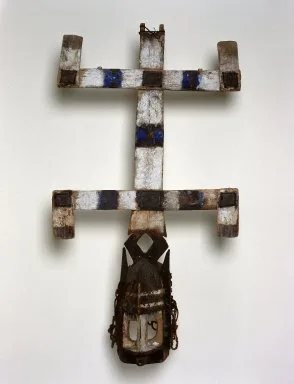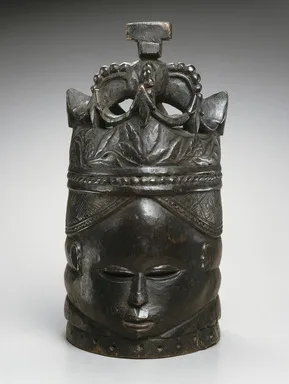African masks are more than mere adornments; they are intricate tapestries woven with the threads of culture, spirituality, and identity. Beyond their aesthetic appeal, these artifacts serve as powerful conduits for communication, transformation, and social commentary. They reveal as much as they conceal, inviting viewers to decipher the hidden meanings embedded within their forms and symbols.
Accordingly, exploration delves into the multifaceted role of African masks, examining how they have been utilized as tools for rituals, ceremonies, and social change.

Masks as Metamorphosis
At their core, African masks embody the belief in the fluidity of identity, the oscillation between the seen and unseen, and the power of transformation. By donning a mask, a wearer undergoes a symbolic metamorphosis, stepping into a new role or identity and this transformation is not merely physical but also spiritual, allowing for a connection with ancestral spirits or divine forces.
For example, the Kanaga masks of the Dogon people of Mali which is a potent symbol of transformation and fluidity, worn during the dama ritual to escort souls to the spirit world. Its design has multiple interpretations, representing a bird, god, or the connection between sky and earth, reflecting the complexity and multifaceted nature of identity.
The mask is one of many used in the dama ritual, which features over 80 types of masks representing various human characters, animals, and concepts, allowing the wearers to embody different identities and roles.
Through this masking tradition, the Dogon highlight the fluidity of identity, demonstrating that individuals can assume different roles and characteristics throughout their lives, and this ritual marks a transformation not only for the deceased but also for the living, who shed their mourning and assume new roles, further emphasizing the dynamic and ever-changing nature of human experience.

Concealing and Revealing
The enigmatic nature of masks is central to their power. While they conceal the wearer’s identity, they simultaneously reveal deeper truths about the community. The geometric patterns, animal motifs, and human features carved into the mask are often imbued with symbolic meaning, conveying messages about social status, gender roles, or spiritual beliefs. These visual codes serve as a form of encrypted communication, accessible only to those initiated into the cultural context.
Through this coded language, the masks reveal the complexities of social hierarchy, gender dynamics, and spiritual practices.
The fact that mask carvers are typically male and hold high status underscores the significance of masks in reinforcing social structures.
Similarly, the prohibition on women wearing masks in most communities highlights the gendered nature of these symbols. Yet, exceptions like the Sande Society, where women wear masks to represent ideal femininity, demonstrate the fluidity of these codes. Ultimately, the masks’ power lies in their ability to conceal and reveal, to encrypt and decode, making them a fascinating window into the cultural contexts that create them.

Ritual and Performance
African masks are integral to ritualistic performances, where they serve as intermediaries between the human and spiritual realms. The masks of the Yoruba people of Nigeria, for instance, are central to the celebration of Ifa religion which ties in the Orishas, the divine forces governing various aspects of life. During festivals, masked dancers embody these deities, enacting sacred dramas that reinforce community bonds and reaffirm cultural values.

Modern Interpretations
Contemporary African artists continue to draw inspiration from traditional mask-making, reimagining them to address contemporary issues. Romuald Hazoumé, a Beninese artist, exemplifies this by crafting masks from discarded materials like plastic bottles, cans, and other waste. His use of recycled materials comments on the impact of globalization and consumerism on African societies, critiquing the effects of pollution and waste on the environment and culture.
Through his work, such as the “La Bouche du Roi” series, Hazoumé highlights the ongoing relevance of masks as a medium for social commentary, challenging viewers to confront the consequences of modernization and environmental neglect.
Ultimately, his masks demonstrate the enduring power of the mask as a medium for social commentary and cultural critique, showcasing its continued potency as a symbol of cultural resilience and critique.
African masks are more than just aesthetic objects; they are living repositories of cultural knowledge. By understanding the symbolism, ritualistic significance, and contemporary interpretations of these masks, we gain deeper insights into the rich and complex tapestry of African societies.
The mask, as a powerful metaphor, continues to shape narratives, challenge perceptions, and inspire new forms of artistic expression.



5 Comments
Pingback: The Relationship between Traditional African Art and Religion - Art Network Africa
some genuinely wonderful work on behalf of the owner of this web site, utterly great written content.
You are appreciated!
Can the wearing of African masks lead to a cultural appropriation of identities and traditions, or does it foster a deeper understanding and appreciation of African cultures?”,
“refusal
Wearing African masks can be complex. It depends on intent, context & cultural sensitivity. Essentially, it can either foster appreciation & understanding, or perpetuate appropriation & stereotyping. Discretion & awareness are key.